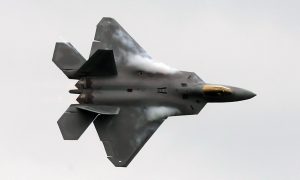Audio of US Fighter Pilot Who Shot Down Chinese Spy Balloon Reveals Lake Huron Strategy
Audio recordings of radio chatter taken during the United States’ shoot down of a Chinese spy balloon earlier this month may provide insights into how the military later shot down an unidentified object over Lake Huron. In over 20 minutes of radio chatter, U.S. pilots and ground teams can be heard discussing their approach and shoot down of the Chinese spy balloon off the coast of South Carolina. The audio was captured by aviation radio enthusiast Ken Harrell and first published by The Drive. The Air Force declined to share its own audio files but confirmed the authenticity of the recordings to The Epoch Times. In one exchange, the lead fighter pilot and his wingman can both be heard preparing their missiles to fire on the balloon, suggesting that the wingman was prepared to take down the balloon immediately following a failed attempt by the lead pilot. “FRANK01 is switches hot,” the lead pilot says. “FREANK02 is switches hot,” the wingman follows. The two F-22 stealth fighters’ call signs, FRANK01 and FRANK02, were named after World War I flying ace Frank Luke Jr., who earned the epithet of “Arizona Balloon Buster” for his successful shootdowns of 14 German balloons during the conflict. Notably, the brief exchange may reveal exactly what happened during the United States shoot down of an unidentified object over Lake Huron on Feb. 12. During that encounter, the lead pilot fired an AIM-9X missile at the object, the same type of missile used on the Chinese spy balloon and two other unidentified objects this month. That missile missed, however, plunging into the waters of Lake Huron. The object was instead destroyed by a second missile fired by the pilot’s wingman. The difficulty in targeting the unknown object was likely expected, given that it was only about as large as a car, and, once again, audio from the initial encounter with the Chinese spy balloon demonstrated the difficulty that aircraft might have in targeting balloons with such slow speeds and low temperatures. In one segment of audio, a supporting pilot in an F-15C can be heard expressing just that problem with the Chinese spy balloon. “I’m having trouble keeping a radar lock for any more than a second on him,” the pilot said. “I will keep trying.” Later, a call from the U.S. Air Force’s Eastern Air Defense Sector, which was controlling the operation from the ground, clarifies that the pilots are authorized to use any weapons they deem necessary to take the balloon down.

Audio recordings of radio chatter taken during the United States’ shoot down of a Chinese spy balloon earlier this month may provide insights into how the military later shot down an unidentified object over Lake Huron.
In over 20 minutes of radio chatter, U.S. pilots and ground teams can be heard discussing their approach and shoot down of the Chinese spy balloon off the coast of South Carolina.
The audio was captured by aviation radio enthusiast Ken Harrell and first published by The Drive. The Air Force declined to share its own audio files but confirmed the authenticity of the recordings to The Epoch Times.
In one exchange, the lead fighter pilot and his wingman can both be heard preparing their missiles to fire on the balloon, suggesting that the wingman was prepared to take down the balloon immediately following a failed attempt by the lead pilot.
“FRANK01 is switches hot,” the lead pilot says.
“FREANK02 is switches hot,” the wingman follows.
The two F-22 stealth fighters’ call signs, FRANK01 and FRANK02, were named after World War I flying ace Frank Luke Jr., who earned the epithet of “Arizona Balloon Buster” for his successful shootdowns of 14 German balloons during the conflict.
Notably, the brief exchange may reveal exactly what happened during the United States shoot down of an unidentified object over Lake Huron on Feb. 12.
During that encounter, the lead pilot fired an AIM-9X missile at the object, the same type of missile used on the Chinese spy balloon and two other unidentified objects this month.
That missile missed, however, plunging into the waters of Lake Huron. The object was instead destroyed by a second missile fired by the pilot’s wingman.
The difficulty in targeting the unknown object was likely expected, given that it was only about as large as a car, and, once again, audio from the initial encounter with the Chinese spy balloon demonstrated the difficulty that aircraft might have in targeting balloons with such slow speeds and low temperatures.
In one segment of audio, a supporting pilot in an F-15C can be heard expressing just that problem with the Chinese spy balloon.
“I’m having trouble keeping a radar lock for any more than a second on him,” the pilot said. “I will keep trying.”
Later, a call from the U.S. Air Force’s Eastern Air Defense Sector, which was controlling the operation from the ground, clarifies that the pilots are authorized to use any weapons they deem necessary to take the balloon down.












